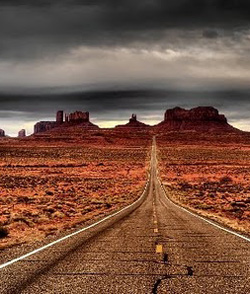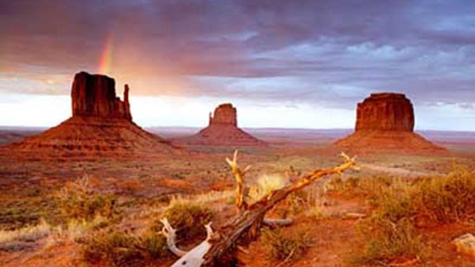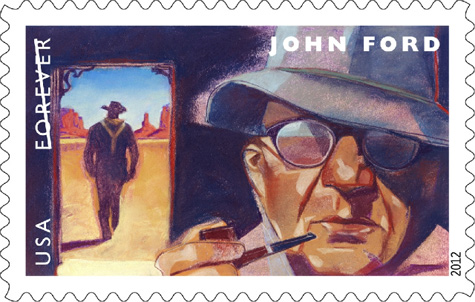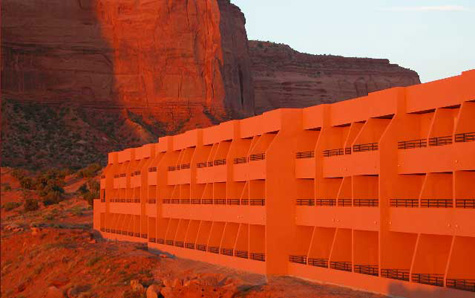
It is impossible to enter Monument Valley without awe. The desert floor is flat and burnt red, like the surface of Mars. The United States is a beautiful country with many landscapes, but—let’s be honest—you can easily drive down a random tree-lined stretch of road in New Jersey that resembles a random stretch of road in two dozen other states. If you’ve seen one two-lane blacktop littered with Exxons and Burger Kings, you’ve more or less seen them all. But then you come to Monument Valley, and you’re immediately reminded of the wondrous variety of the North American continent.
Rising from the valley floor are the monuments themselves, massive siltstone buttes that look like rock sculptures etched by ancient gods. In a way, of course, they were. Eons of erosion carved away layer after layer of sandstone, until the valley became a gallery of towering abstract statues.

Like many people, I learned about Monument Valley from the movies. It was, most famously, known as “John Ford country” because of the great director’s fondness for the area. Ford, a crusty and peculiar man, had his own way of doing things. Every year or so, he would load up a merry band of collaborators, a seasoned crew and his stock company of actors, and decamp to the valley to make yet another stark Western drama. With his faithful protégée, and most famous star, John Wayne, Ford made masterpieces like Stagecoach, She Wore a Yellow Ribbon, and The Searchers. With Henry Fonda he made the romantic My Darling Clementine (still the best Wyatt Earp movie). And he paired Wayne and Fonda in a battle of wills in that underrated critique of revisionist history Fort Apache.
If anything, Ford can be faulted for relying too much on the area. Texas-partisan Tommy Lee Jones has said, for instance, that he can’t stand to watch The Searchers because the film, which takes place in Texas, never leaves the Utah-Arizona border. Another criticism that is perhaps inevitable is that Ford was a white filmmaker coming into the area to utilize the land and fetishize the people. Despite a late-career attempt to tell the Native American side of the story with his Cheyenne Autumn (also shot in the valley), Ford can be charged, and easily found guilty, of portraying mostly negative stereotypes of native peoples in his films. As with all art, one has to consider the context of the culture and time: that many of Ford’s films were made without sensitivity to the plight of the native peoples, and without attention to the often blood-splattered history of the American government, is beyond dispute.
What is also beyond dispute, however, is that Ford used the area in a way most filmmakers and film lovers can still admire. His eye for composition was impeccable. I’ve long been a fan of The Searchers, but the film hit me as a revelation a few years ago when I was able to see it on the big screen for the first time. Ford came up in silent film, long before the advent of television, so he always composed images with the silver screen in mind. His vistas of Monument Valley cannot be fully appreciated on a small screen. Moreover, in something like The Searchers he uses the barren landscape to dwarf the passion of his human characters. Gunshots fired in fury are swallowed into the empty spaces like distant bark of a dog.

Ford undoubtedly did a lot of good for the Navajo Nation by filming his movies in the valley, employing the people as riders and extras, pumping money into the local economy, and setting up the area as a world famous icon of the American west. When many people around the globe think of the West, they picture Monument Valley, and that owes much to Ford’s devotion to the place.
As good as Ford’s films are, when one visits the actual place, it’s rather difficult to remember the movies. Hiking the Wildcat Trail, you descend off a bluff overlooking the valley and start the four-mile trek among the sand dunes surrounding the massive Left Mitten Butte. Walking in the shadow of this colossal monolith is a study in the smallness of humanity. When I was there this January (which, temperature-wise, is an excellent time to go) the desert floor was warm in the morning, but as my partner and I passed into the massive shadow of the butte everything turned cold. I couldn’t help but be struck by the reality that this tower had stood in this valley for thousands of years as bands of human beings scurried beneath its shadow to escape the heat. Many people will be drawn to this place because John Wayne made some movies here, but in the place itself humanity is leveled. It’s difficult to remain impressed by the meager achievements of men while standing in the presence of timeless treasures of nature.

Monument Valley has had millions of visitors, but it remains one of the great, undervalued destination sites in America. The Navajo Nation runs The View Hotel, a beautiful facility with a spacious restaurant and gift shop that looks down off a bluff into the valley. If you stay there, wake up early enough to watch the sun come up. It’s like watching the world be born.
Jake Hinkson, The Night Editor, is the author of Hell on Church Street.

I’ve only been out that way once (I’m a Florida girl), but what a gorgeous gorgeous area. You describe it beautifully, and now I want to go back!
guess what, you use a photo without the credits. Should I sue you for copyright infrigement? what is your excuse to do so?